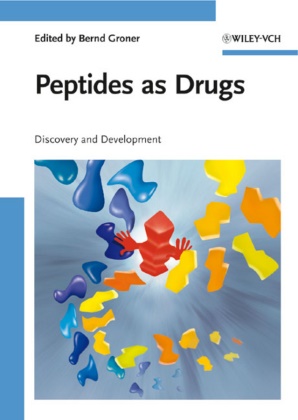Share
Fr. 194.00
Bernd Groner, Bern Groner, Bernd Groner
Peptides as Drugs - Discovery and Development
English · Hardback
Shipping usually within 3 to 5 weeks
Description
By covering the full spectrum of topics relevant to peptidic drugs, this timely handbook serves as an introductory reference for both drug developers and biomedical researchers interested in pharmaceutically active peptides, presenting both the advantages and challenges associated with this molecular class.The first part discusses current approaches to developing pharmaceutically active peptides, including case studies of the use of peptidic drugs in cancer and AIDS therapy. The second part surveys strategies for the development and targeting of peptidic drugs.With its integration of biochemical, pharmaceutical and clinical research, this work reveals the full picture of modern peptide drug research in a single volume, making it an invaluable reference for medicinal chemists, biochemists, biotechnologists, and those in the pharmaceutical and biotechnological industries.
List of contents
PEPTIDES AS DRUGS: DISCOVERY AND DEVELOPMENTDiscovery of New Potential Drug Targets and the Limitations of DruggabilityProtein Interaction Domains are at the Core of Signaling PathwaysPeptides as Inhibitors of Protein InteractionsMIMICS OF GROWTH FACTORS AND CYTOKINESIntroductionThe CytokinesDefining Receptor Recognition Sites in Cytokines Using Chimeric ProteinsReceptor Recognition Sites are Organized as Exchangeable ModulesThe Concept of Fusing the Cytokine to the Soluble Receptor: Hyper-IL-6Antagonists Specifically Inhibiting IL-6 Trans-SignalingIn Vitro Evolution of Peptides and ProteinsPEPTIDES DERIVED FROM EXON v& OF THE CD$$ EXTRACELLULAR DOMAIN PREVENT ACTIVATION OF RECEPTOR TYROSINE KINASE AND SUBSEQUENTLY ANGIOGENESIS AND METASTATIC SPREAD OF TUMOR CELLSIntroductionCD44 Proteins and Their Involvement in RTK ActivationCD44v6 Acts as a Coreceptor for c-Met and RonThree Amino Acids in CD44 Exon v6 are Crucial for the CD44v6 Coreceptor Function, and Small Peptides Can Interfere with This FunctionThe Ectodomain of CD44v6 Binds to HGFPeptides Corresponding to Exon v6 of CD44 Inhibit Metastatic Spread of Tumor CellsThe Significance of the Collaboration Between CD44v6 and c-Met In VivoThe CD44v6 Peptides Interfere with AngiogenesisPEPTIDE APTAMERS TARGETING THE VIRAL E6 ONCOPROTEIN INDUCE APOPTOSIS IN HPV-POSITIVE CANCER CELLSHuman Papillomaviruses and OncogenesisPeptide Aptamers Targeting the HPV E6 OncoproteinE6-Targeting Peptide Aptamers: Therapeutic PerspectivesPerspectivesTHE PREVENTION OF HIV INFECTION WITH VIRAL ENTRY INHIBITORSIntroduction: The Potential of Peptides as Drugs in the Treatment of HIV InfectionThe HIV Entry ProcessPeptides that Inhibit Receptor or Coreceptor BindingInhibitors of the Viral and Cellular Membrane Fusion ProcessEntry Inhibitory Peptides Selected by the Phage Display TechnologyLimitations of Peptides it the Treatment of HIV InfectionStrategies to Prolong the In Vivo Half-Life of Antiviral PeptidesAntiviral Peptides in Gene Therapy of HIV InfectionINTRACELLULAR EXPRESSION OF PEPTIDESIntroductionPeptide Design and Expression CassettesStable Delivery and Expression of Peptides: Gamma-Retro- and Lentiviral VectorsGamma-Retroviral VectorsLentiviral Peptide DeliveryVectors for Transient Expression of Peptides: Adenoviruses and Adeno-Associated VirusesPerspectiveTHE INTERNALIZATION MECHANISMS AND BIOACTIVITY OF THE CELL-PENETRATING PEPTIDESIntroductionDiscovery and Classification of CPPsInternalization Mechanisms of Cell-Penetrating PeptidesModels of CPP UptakeThe Current View of CPP UptakeCPPs as Cargo Delivery VehiclesDelivery of ProteinsCPPs in Gene DeliveryDelivery of OligonucleotidesCytotoxicity of Cell-Penetrating PeptidesIn Vivo Drug Delivery with CPPsCPPs for Targeted DeliveryPRODUCTION AND PURIFICATION OF MONOMERIC RECOMBINANT PEPTIDE APTAMERS: REQUIREMENTS FOR EFFICIENT INTRACELLULAR UPTAKE AND TARGET INHIBITIONIntroductionProtein ProductionProtein PurificationIsolation of Monomeric, Natively Folded ProteinsIncreasing Peptide Production, Purification and Efficacy by Using ScaffoldsThe Use of Cell-Penetrating Peptides for Cellular Uptake of Purified ProteinsClassification of Therapeutic PeptidesProduction and Administration of Therapeutic Peptides In VivoPEPTIDE ARRAYS ON SOLID SUUPORTS: A TOOL FOR THE IDENTIFICATION OF PEPTIDE LIGANDSIntroductionSynthesis of Peptide ArraysApplications of Peptide ArraysChallenges in High-Throughput Screening (HTS)Future Perspectives
About the author
Bernd Groner is the head of the Georg Speyer Haus, an independent biomedical research institute in Frankfurt am Main (Germany). He studied biochemistry at the University of Pittsburgh (USA) and did postdoctoral work at Columbia University in New York, the Max-Planck-Institute for Molecular Genetics in Berlin, and the Swiss Institute for Experimental Cancer Research in Lausanne. From 1993 to 1998, he served as Director of the Institute for Experimental Cancer Research in Freiburg (Germany), before taking up his current post at the Georg Speyer Haus. He is a widely recognized authority on peptide hormones and has pioneered the design of peptides as pharmacological modulators of cell signaling.
Summary
By covering the full spectrum of topics relevant to peptidic drugs, this timely handbook serves as an introductory reference for both drug developers and biomedical researchers interested in pharmaceutically active peptides, presenting both the advantages and challenges associated with this molecular class.
The first part discusses current approaches to developing pharmaceutically active peptides, including case studies of the use of peptidic drugs in cancer and AIDS therapy. The second part surveys strategies for the development and targeting of peptidic drugs.
With its integration of biochemical, pharmaceutical and clinical research, this work reveals the full picture of modern peptide drug research in a single volume, making it an invaluable reference for medicinal chemists, biochemists, biotechnologists, and those in the pharmaceutical and biotechnological industries.
Product details
| Authors | Bernd Groner |
| Assisted by | Bern Groner (Editor), Bernd Groner (Editor) |
| Publisher | Wiley-VCH |
| Languages | English |
| Product format | Hardback |
| Released | 31.03.2015 |
| EAN | 9783527322053 |
| ISBN | 978-3-527-32205-3 |
| No. of pages | 226 |
| Dimensions | 179 mm x 249 mm x 17 mm |
| Weight | 612 g |
| Illustrations | 35 SW-Abb., 3 Farbabb., 8 Tabellen |
| Subjects |
Natural sciences, medicine, IT, technology
> Chemistry
Chemie, Arzneimittel, Biochemie, Medizin, Medizin, Gesundheit, chemistry, PEPTIDE, Pharmacology & Pharmaceutical Medicine, Pharmakologie u. Pharmazeutische Medizin, Wirkstoffforschung u. -entwicklung, Drug Discovery & Development, Medical Science, Biomolecules (DNA, RNA, Peptides, etc.), Biomoleküle (DNA, RNA, Peptide) |
Customer reviews
No reviews have been written for this item yet. Write the first review and be helpful to other users when they decide on a purchase.
Write a review
Thumbs up or thumbs down? Write your own review.

